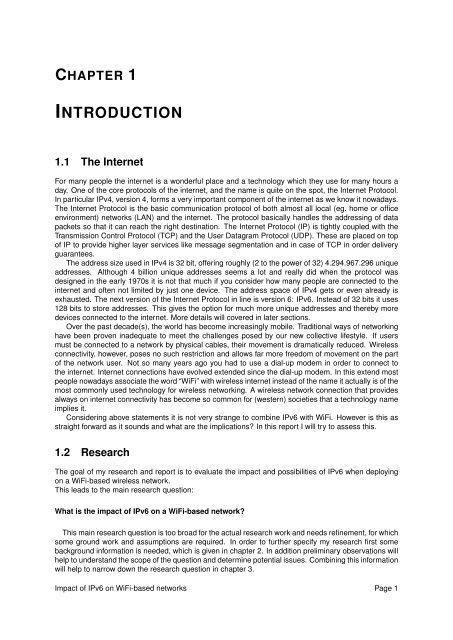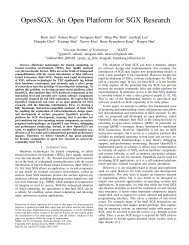Create successful ePaper yourself
Turn your PDF publications into a flip-book with our unique Google optimized e-Paper software.
CHAPTER 1<br />
INTRODUCTION<br />
1.1 The Internet<br />
For many people the internet is a wonderful place and a technology which they use for many hours a<br />
day. One of the core protocols of the internet, and the name is quite on the spot, the Internet Protocol.<br />
In particular IPv4, version 4, forms a very important component of the internet as we know it nowadays.<br />
The Internet Protocol is the basic communication protocol of both almost all local (eg. home or office<br />
environment) networks (LAN) and the internet. The protocol basically handles the addressing of data<br />
packets so that it can reach the right destination. The Internet Protocol (IP) is tightly coupled with the<br />
Transmission Control Protocol (TCP) and the User Datagram Protocol (UDP). These are placed on top<br />
of IP to provide higher layer services like message segmentation and in case of TCP in order delivery<br />
guarantees.<br />
The address size used in IPv4 is 32 bit, offering roughly (2 to the power of 32) 4.294.967.296 unique<br />
addresses. Although 4 billion unique addresses seems a lot and really did when the protocol was<br />
designed in the early 1970s it is not that much if you consider how many people are connected to the<br />
internet and often not limited by just one device. The address space of IPv4 gets or even already is<br />
exhausted. The next version of the Internet Protocol in line is version 6: IPv6. Instead of 32 bits it uses<br />
128 bits to store addresses. This gives the option for much more unique addresses and thereby more<br />
devices connected to the internet. More details will covered in later sections.<br />
Over the past decade(s), the world has become increasingly mobile. Traditional ways of networking<br />
have been proven inadequate to meet the challenges posed by our new collective lifestyle. If users<br />
must be connected to a network by physical cables, their movement is dramatically reduced. Wireless<br />
connectivity, however, poses no such restriction and allows far more freedom of movement on the part<br />
of the network user. Not so many years ago you had to use a dial-up modem in order to connect to<br />
the internet. Internet connections have evolved extended since the dial-up modem. In this extend most<br />
people nowadays associate the word “WiFi” with wireless internet instead of the name it actually is of the<br />
most commonly used technology for wireless networking. A wireless network connection that provides<br />
always on internet connectivity has become so common for (western) societies that a technology name<br />
implies it.<br />
Considering above statements it is not very strange to combine IPv6 with WiFi. However is this as<br />
straight forward as it sounds and what are the implications? In this report I will try to assess this.<br />
1.2 Research<br />
The goal of my research and report is to evaluate the impact and possibilities of IPv6 when deploying<br />
on a WiFi-based wireless network.<br />
This leads to the main research question:<br />
What is the impact of IPv6 on a WiFi-based network?<br />
This main research question is too broad for the actual research work and needs refinement, for which<br />
some ground work and assumptions are required. In order to further specify my research first some<br />
background information is needed, which is given in chapter 2. In addition preliminary observations will<br />
help to understand the scope of the question and determine potential issues. Combining this information<br />
will help to narrow down the research question in chapter 3.<br />
Impact of IPv6 on WiFi-based networks Page 1







